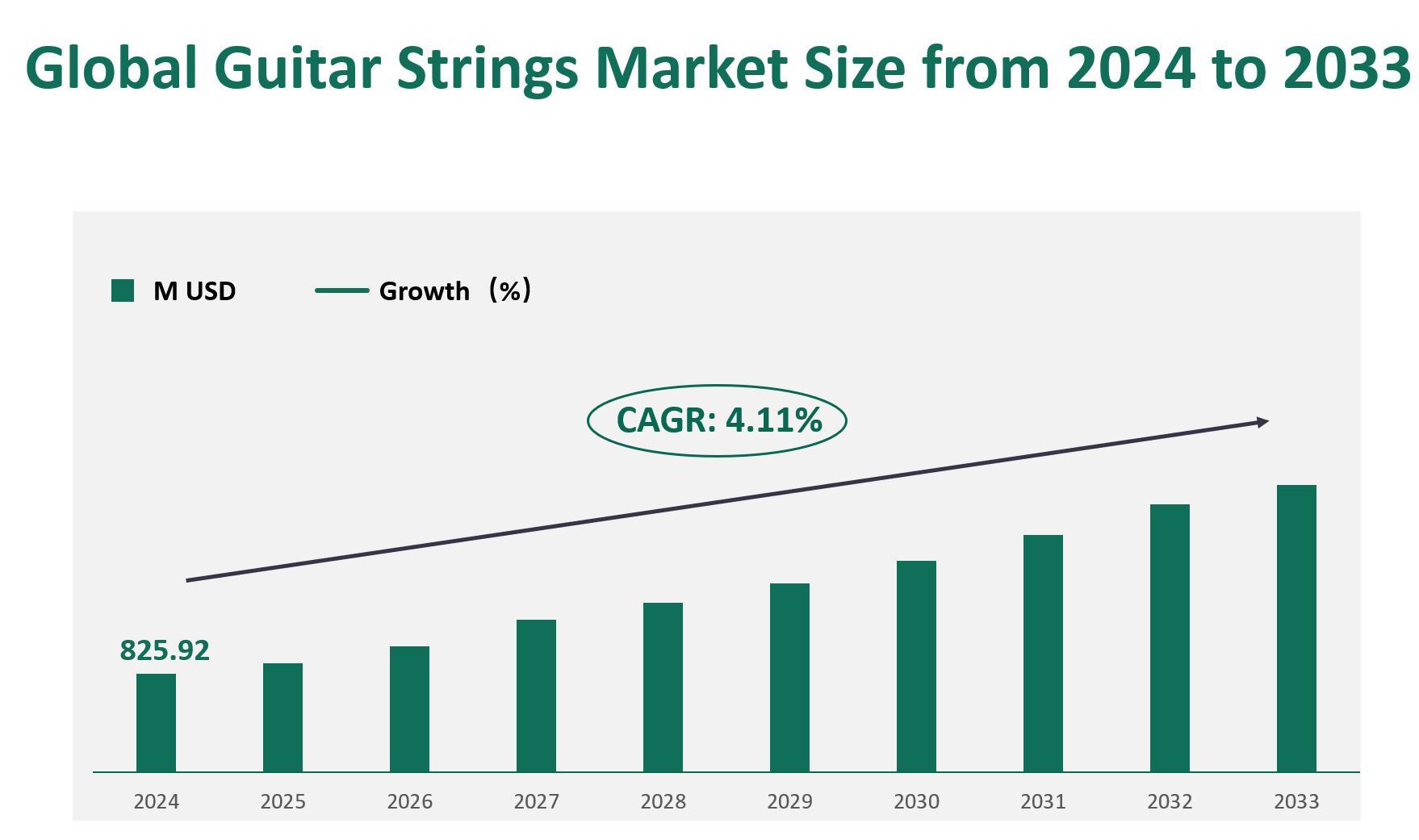1. Global Guitar Strings Market Insight Analysis
In 2024, the global guitar strings market is projected to generate a revenue of 825.92 million USD. The market is expected to maintain a Compound Annual Growth Rate (CAGR) of 4.11% from 2024 to 2033.
Guitar strings are essential components of guitars, designed to vibrate and produce musical notes. They are typically made from materials such as gut, nylon, or steel, and are used on both acoustic and electric guitars. The choice of material and construction significantly impacts the sound quality, durability, and performance of the strings. Over the years, the industry has seen significant technological advancements, leading to the development of coated strings, improved alloys, and enhanced manufacturing processes. These innovations have not only extended the lifespan of guitar strings but also improved their tonal qualities, making them more appealing to musicians and guitar enthusiasts.
Figure Global Guitar Strings Market Size (M USD) and CAGR (2024-2033)

2. Driving and Limiting Factors of Guitar Strings Market Growth
The growth of the guitar strings market is influenced by several driving factors. One of the primary drivers is the increasing sales of guitars worldwide. The popularity of guitar as a musical instrument has surged, particularly during the COVID-19 pandemic, as more people took up learning to play the guitar. According to Music Trades, retail sales of musical instruments and gear reached $8.9 billion in 2021, marking a 22% increase. This trend has broadened the downstream market for guitar strings, creating more opportunities for manufacturers.
Another significant driver is the rise of e-commerce. Online sales platforms have improved the accessibility and distribution of guitar strings, making it easier for consumers to purchase them. This has not only expanded the market reach but also increased consumer convenience, leading to higher sales volumes.
However, the market also faces several limiting factors. One of the primary challenges is the fluctuation in raw material prices. Steel and nylon, which are key materials for guitar strings, have seen significant price volatility due to supply chain disruptions and global economic conditions. The ongoing conflict between Russia and Ukraine has further exacerbated these issues, leading to increased production costs for manufacturers.
Product homogenization is another challenge. The market has seen a proliferation of similar products, leading to intense competition and a potential decline in product quality. This has resulted in a “race to the bottom” in terms of pricing, which can negatively impact the profitability of manufacturers.
3. Technological Innovation in the Guitar Strings Market
Technological innovation has played a crucial role in the development of the guitar strings market. Companies are continuously investing in research and development to improve the performance and longevity of their products. For instance, D’Addario’s XT Coating technology combines high carbon steel core wires with an extended lifespan treatment, enhancing durability and pitch stability. Similarly, Elixir Strings’ Optiweb Coating offers a lightweight coating that extends the tone life of the strings without compromising their natural sound.
Corporate mergers and acquisitions have also shaped the industry landscape. For example, D’Addario acquired National Picks in October 2021, expanding its product portfolio and strengthening its position in the market. Such strategic moves allow companies to diversify their offerings, gain access to new technologies, and enhance their market share.
Moreover, the industry has seen the introduction of new materials and manufacturing processes. The use of advanced alloys and coatings has improved the tonal qualities and durability of guitar strings. Companies are also focusing on sustainability, with initiatives like the Playback string recycling program by D’Addario and Martin, which aims to recycle used guitar strings.
4. Global Guitar Strings Market Size by Type
Guitar strings are essential components of guitars, providing the necessary tension and vibration to produce sound. The market for guitar string is diverse, with various types catering to different needs and preferences of guitar players. The main types of guitar string include electric guitar string, acoustic guitar string, and others (such as classical and specialty strings).
Electric guitar strings are designed specifically for electric guitars, which rely on magnetic pickups to amplify the sound. These strings are typically made from materials like steel, nickel, and other alloys, which enhance their magnetic properties and produce a bright, clear tone. In 2024, the market revenue for electric guitar string is projected to be $282.49 million. The market share for electric guitar strings is expected to be around 34.20%, making it the second-largest segment in terms of revenue.
Acoustic guitar strings are designed for acoustic guitars, which produce sound through the vibration of the strings and the resonance of the guitar body. These strings are often made from materials like bronze, brass, and nylon, which provide a warm, rich tone. In 2024, the market revenue for acoustic guitar strings is projected to be $411.04 million. This segment holds the largest market share, accounting for approximately 49.77% of the total revenue.
Among the different types of guitar strings, acoustic guitar strings hold the largest market share, accounting for nearly half of the total market revenue. This is due to the widespread popularity of acoustic guitars in various music genres and the demand for high-quality strings that enhance the natural sound of the instrument. Electric guitar strings, while having a significant market share, are slightly behind acoustic strings in terms of revenue.
Table Global Guitar Strings Market Size by Type in 2024
|
Market Size (M USD) 2024 |
Market Share | |
Electric Guitar String |
282.49 |
34.20% |
Acoustic Guitar String |
411.04 |
49.77% |
|
Others |
132.39 |
16.03% |
5. Global Guitar Strings Market Size by End User
The end users of guitar strings can be broadly categorized into individual amateurs, learning and training institutions, and professional performers.
Individual amateurs represent the largest segment of end users in the guitar strings market. These are individuals who play the guitar as a hobby or for personal enjoyment. They often purchase guitar strings to replace worn-out ones or to experiment with different types of strings to achieve their desired sound. In 2024, the market revenue generated by individual amateurs is projected to be $589.49 million. This segment holds the largest market share, accounting for approximately 71.37% of the total revenue.
Learning and training institutions include music schools, colleges, and other educational facilities that teach guitar playing. These institutions purchase guitar strings in bulk for their students and often prefer high-quality, durable strings that can withstand frequent use. In 2024, the market revenue for learning and training institutions is projected to be $132.45 million. This segment holds a market share of around 16.04%. The growth rate for this segment is also significant, driven by the increasing interest in music education and the demand for reliable strings that can support the learning process.
Professional performers include musicians who play the guitar as part of their career, either as solo artists or as part of bands and orchestras. These performers require high-quality, durable strings that can withstand the rigors of professional use and produce consistent sound. In 2024, the market revenue for professional performers is projected to be $103.98 million. This segment holds a market share of around 12.59%.
Among the different end users, individual amateurs hold the largest market share, accounting for over 70% of the total market revenue. This is due to the widespread popularity of guitar playing as a hobby and the continuous demand for replacement strings. Learning and training institutions also contribute significantly to the market revenue, driven by the increasing interest in music education. Professional performers, while having a smaller market share, still play a crucial role in the market, especially in driving the demand for high-performance strings.
Table Global Guitar Strings Market Size by End User in 2024
|
End User |
Market Size (M USD) 2024 |
Market Share |
|
Individual Amateurs |
589.49 |
71.37% |
|
Learning and Training |
132.45 |
16.04% |
|
Professional Performance |
103.98 |
12.59% |
6. Global Guitar Strings Market Size by Region
U.S. remains the largest regional market, with a revenue of 239.81 million USD in 2024. The U.S. market is expected to contribute significantly to the global revenue, leveraging its strong consumer base, established distribution channels, and technological advancements.
Europe follows closely, with a revenue of 206.25 million USD in 2024. The European market is characterized by a mature consumer base with a high demand for high-quality guitar strings. The region’s rich musical heritage and strong presence of professional musicians contribute to its steady market performance.
China is the fastest-growing region, with a revenue of 122.09 million USD in 2024. The Chinese government’s promotion of cultural and artistic activities has spurred interest in musical instruments, including guitars. Japan, on the other hand, has a well-established market with a high demand for premium-quality guitar strings. The region’s growth is further supported by technological advancements and increasing exports to other parts of the world.
Latin America is another region experiencing significant growth, driven by countries like Brazil and Mexico. The region’s revneue is 67.35 million USD.
Figure Global Guitar Strings Market Size by Region in 2024

7. Global Guitar Strings Market Analysis by Major Players
7.1 D’Addario
Introduction and Business Overview: D’Addario is a leading manufacturer of musical instrument accessories, including guitar strings, drum heads, and other products. Established in 1974, the company is renowned for its high-quality products and innovative technologies. D’Addario’s XT Coating technology, for example, enhances the durability and performance of guitar strings.
Products: D’Addario offers a wide range of guitar strings, including electric, acoustic, and classical strings. The company’s product line also includes accessories such as picks, tuners, and straps.
Sales Revenue in 2022: D’Addario generated a revenue of $120.47 million USD in 2022.
7.2 Ernie Ball
Introduction and Business Overview: Ernie Ball is a well-known manufacturer of premium guitar strings and accessories. Established in 1962, the company is famous for its Slinky and Earthwood strings, which are popular among musicians worldwide. Ernie Ball’s innovative products and strong brand presence have solidified its position in the market.
Products: Ernie Ball offers a variety of electric, acoustic, and bass guitar strings. The company’s Zippy Slinky set, introduced in 2022, features ultra-light gauge strings, catering to players looking for ease of play and a bright tone.
Sales Revenue in 2022: Ernie Ball’s revenue in 2022 was $44.94 million USD.
7.3 Elixir
Introduction and Business Overview: Elixir is a leading manufacturer of high-quality guitar strings, known for its innovative coatings and long-lasting performance. Established in 1997, the company has a strong reputation for producing strings that maintain their tone and feel over extended periods.
Products: Elixir offers a range of coated strings for electric and acoustic guitars. The company’s Optiweb Coating technology provides a lightweight coating that enhances the lifespan of the strings without compromising their natural sound.
Sales Revenue in 2022: Elixir’s revenue in 2022 was $20.47 million USD.

